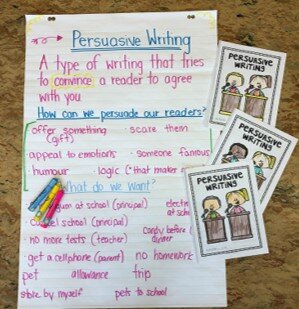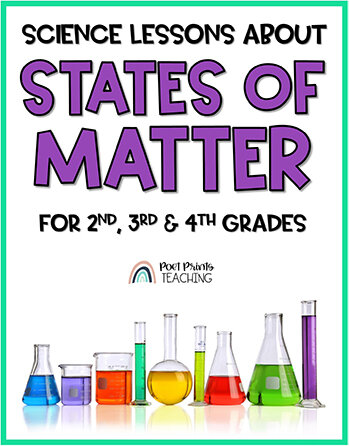“It’s raining cats and dogs,” “Mr. Sun, Mr. Sun”, “Down came the rain and washed the spider out…”, “Cloudy with a chance of meatballs.” The phrases about weather are endless. Kids know songs about the weather. There are stories about the weather. There are popular phrases about the weather. Weather is all around us. And it’s part of the curriculum! Take a look at some of the MOST fun (and educational!) third grade weather and climate activities.
What is the difference between weather and climate?
Weather vs. Climate anchor chart.
Weather is a specific event, like a thunderstorm, rain or snow. Weather might last a short time, like a short rainfall, or it might last longer like a snowstorm that lasts for six days. Climate is the average of all the weather that happens in a place over the past 30 or more years. Climate describes what the weather is normally like in a region. So now that we know the difference between climate and weather, let’s look at some fun 3rd grade weather and climate activities.
We use an anchor chart like the one pictured to help kids really visualize the differences between weather and climate.
Plan Your Weather and Climate Lessons With One Click
Looking for a FAST way to plan out your weather and climate unit that already includes paired nonfiction passages and this project based learning travel brochure? In just a few clicks you can grab all of the pieces you need: lesson plans, paired passages, reading comprehension, key reading skills, and a hands-on science extension. Click and print. Planning is really that easy.
track the weather near and far
Tracking daily weather is a great (and quick!) activity to draw attention to daily weather patterns. This activity doesn’t need to take more than 5-10 minutes, and can be used for math tie-ins later down the road. Once you’ve gathered data on weather and temperature patterns for a number of weeks it’s a great chance to tie in some graphing and data outcomes!
Tracking the weather in two distinct locations is a fun and simple way to gather data and make great scientific observations about weather patterns!
We use a simple notebook journal to record the weather, temperature, and precipitation of our city.
To take this activity to the next level, use the same notebook to compare weather with a far away location. Weather apps are great for this! Have students make notes on the differences that they are seeing. We live in the west coast of Canada, and chose to follow a the weather in a city in Australia. It was so interesting to watch students research the warm daily weather in Australia during our rainy and cold season.
What is the average temperature in our location compared to the far away destination? Do we think their climate is similar to ours or different? , students can even compare and contrast the weather from a far away location to the weather at their school.
Shaving Cream Rain Clouds
Did you know that you can make it rain in a jar and you only need a few materials? Get a glass jar, shaving cream and food coloring. Fill the glass jar with water and put shaving cream on the top. The shaving cream represents the cloud. Then start dripping food coloring on top of the shaving cream. Explain to your students that when the cloud is heavy enough, it will start to rain. Sure enough, when you have put enough food coloring drops on the cloud, it will start to rain.
Pro Tip: Dilute the food coloring with water, otherwise you’ll go through a lot of food coloring drops.
Combine close reading and a travel brochure project
One of my favorite ways to teach about weather and climate is to combine the weather and climate with paired close reading passages. When we dive into informational text it really gives students the background knowledge (and vocabulary!) to be able to interact with the hands-on materials in a new way.
In this unit, we looked at informational texts about Weather and Climate and then dug into a set of paired passages about the weather and climate in two very different locations in the world: Rio de Janeiro and Moscow!
Then, students were asked to imagine that they have been hired by “Terrific Travels”, a fictitious travel agency. In a project-based learning activity, they were tasked with designing a travel brochure for a terrific destination, and needed to include information about the climate and weather! It was a great way to have students show their understanding of climate and weather in a way that wasn’t just worksheets. (Plus, it was so easy to prepare!)
Zip Bag Water Cycle
We learn all about the water cycle in 2nd grade up here in BC, but it fits in so nicely when teaching about weather and climate as well! With just a few household ingredients you can help to quickly explain the water cycle to your students.
Here’s what you’ll need:
A plastic zippered bag
Food coloring
Tape
First, pour some water into the bag. It should be enough to cover the bottom of the bag by ½ inch to an inch. Add a few drops of food coloring so students can see the water better. Blue is preferable to best represent water, but any color works! Close the bag and tape it to a window or a wall facing a window.
As the water warms, it will start to evaporate. But the water vapor won’t be able to escape the bag because the bag is sealed. The water vapor gets trapped at the top of the back and eventually starts to cool. As it cools, it condenses like a cloud. When it condenses enough, it falls down like rain. While this isn’t a perfect illustration, it gives the students a great sense of the water cycle and how clouds and rain form.
































































